PRINCETON, NJ -- Six in 10 unemployed Americans say the next job they get is not likely to be one they want; instead, they'll have to settle for one they don't really want. Four in 10 underemployed adults have similar expectations about a full-time job.

These results are based on a USA Today/Gallup poll conducted as part of Gallup Daily tracking between Dec. 21, 2010, and Jan. 9, 2011. The USA Today/Gallup survey defines unemployed Americans as adults aged 18 and older who are currently out of work but say they are able to work and are actively looking. The unemployed group also includes out-of-work adults who are not currently looking for a job, but who plan to look in the future. The latter constitute so-called discouraged workers, who are commonly considered out of the workforce and therefore are not included in standard government or Gallup unemployment figures. Underemployed Americans are those working part time, but who would like to work full time.
Unemployed, Underemployed Relate a Discouraging Job Search Process
Despite today's nearly double-digit unemployment rate, 4 in 10 unemployed Americans expect to get a job in the next four weeks and one in three underemployed have the same expectations with respect to obtaining a full-time job.
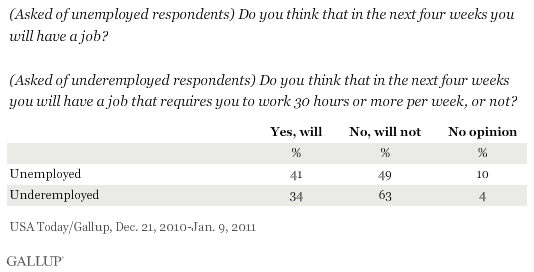
On average, unemployed workers report that they have spent 27 weeks actively looking for a job. Further, they say they have applied on average for 45 different jobs, while the underemployed, on average, report applying for 19 different full-time jobs.
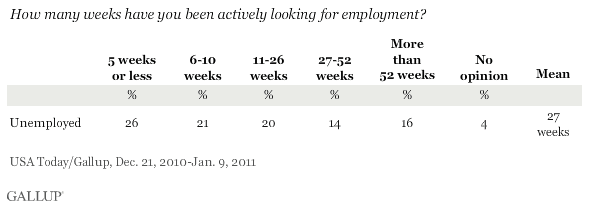

Unemployed Americans, despite applying for far more jobs than the underemployed, report getting on average a similar number of job interviews. The unemployed have had on average five interviews with a specific employer about a specific job, and the underemployed report an average of four interviews about a specific full-time job.
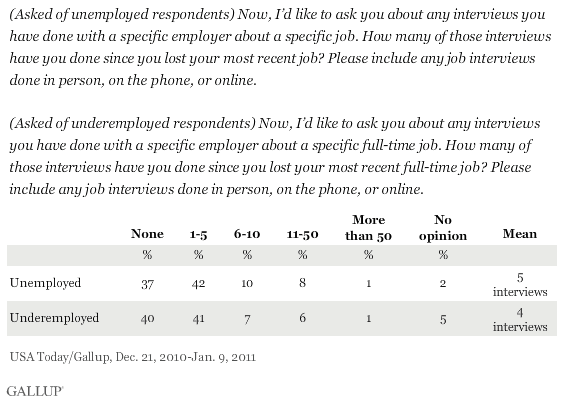
Most Unemployed, Underemployed Willing to Take Same Pay or Pay Cut
Frequently, people forced to seek a different job lose some of the pay associated with the experience and skills they used in their prior job. The large majorities of the currently unemployed (73%) and underemployed (62%) made less than $60,000 a year before taxes in their previous job. Slightly more are willing to accept less than $60,000 a year in order to get a new job.
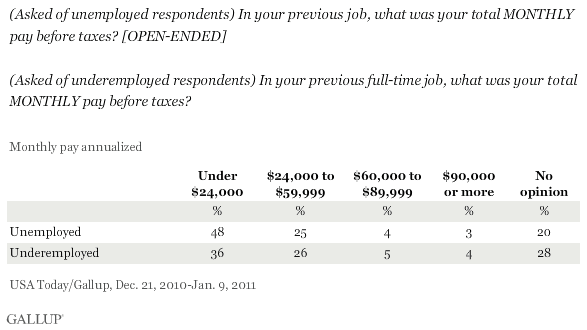
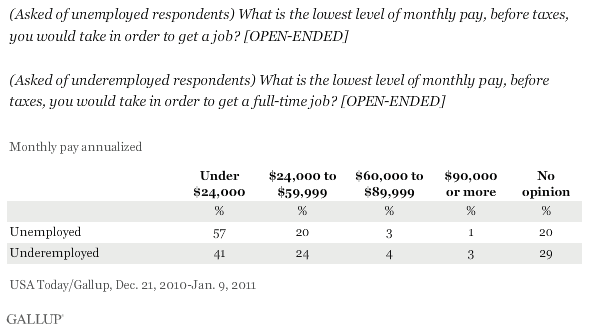
Bottom Line
It seems clear that the current unemployment situation does not result from unwillingness on many Americans' part to take a job they don't want. Nor are many Americans unwilling to take a job that provides them with the same or lower income. Instead, significant portions of unemployed and underemployed Americans believe they will have to take any job, even if they don't want it, and majorities are willing to take the same pay or a pay cut in a new job. Although many of the unemployed are discouraged right now and have stopped looking for work, those who are actively looking are making the job search a job in itself. Unfortunately, their relative lack of interview opportunities may partly explain why so many have become discouraged.
Further, data from the same poll find that these Americans face more than financial struggles. Not only are one in four unemployed individuals experiencing financial distress, but similar numbers are experiencing major problems in their relationships, and, separately, have sought professional medical help for stress or other major health problems.
On the other hand, the recent increases in economic confidence and the relative steadiness of the job market provide some hope that the job situation will improve, at least at a modest pace, during the months ahead. Similarly, 4 in 10 unemployed Americans expect their job search efforts to pay off in as little as four weeks, reflecting some added optimism that all unemployed, underemployed, and discouraged workers may want to keep in mind.
Survey Methods
Unemployed and underemployed results are based on telephone interviews conducted as part of Gallup Daily tracking from Dec. 21, 2010-Jan. 9, 2011, with a random sample of 15,120 adults, aged 18 and older, living in all 50 U.S. states and the District of Columbia, selected using random-digit-dial sampling.
For results based on the subgroup of 1,145 unemployed Americans, one can say with 95% confidence that the maximum margin of sampling error is ±4 percentage points. Unemployed Americans are defined as not currently working and either actively looking for work or not actively looking for work now, but saying they want to work 30 or more hours per week and saying they plan to actively look for work in the future.
For results based on the subgroup of 675 underemployed Americans one can say with 95% confidence that the maximum margin of sampling error is ±5 percentage points. Underemployed Americans are defined as currently working a part-time job but wanting to work a full-time job.
The national adult and non-unemployed/underemployed results reported for comparison in this article are based on telephone interviews conducted as part of Gallup Daily tracking on Dec. 21, 2010, with a random sample of 1,009 adults, aged 18 and older, living in all 50 U.S. states and the District of Columbia, selected using random-digit-dial sampling.
For results based on the total sample, one can say with 95% confidence that the maximum margin of sampling error is ±4 percentage points.
Interviews are conducted with respondents on landline telephones and cellular phones, with interviews conducted in Spanish for respondents who are primarily Spanish-speaking. Each daily sample includes a minimum quota of 200 cell phone respondents and 800 landline respondents, with additional minimum quotas among landline respondents for gender within region. Landline respondents are chosen at random within each household on the basis of which member had the most recent birthday.
Samples are weighted by gender, age, race, Hispanic ethnicity, education, region, adults in the household, cell phone-only status, cell phone-mostly status, and phone lines. Demographic weighting targets are based on the March 2010 Current Population Survey figures for the aged 18 and older non-institutionalized population living in U.S. telephone households. All reported margins of sampling error include the computed design effects for weighting and sample design.
In addition to sampling error, question wording and practical difficulties in conducting surveys can introduce error or bias into the findings of public opinion polls.
View methodology, full question results, and trend data.
For more details on Gallup's polling methodology, visit www.gallup.com.
